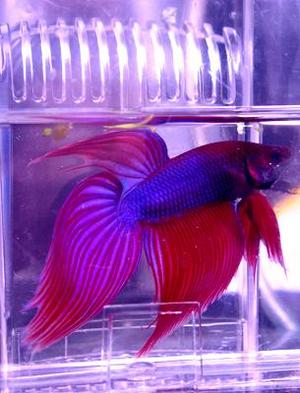Chosen for their beauty, color, and sail like splaying fins, Splenden Betta fish are among the most popular pet fish in the United States. Their brilliant colors are dramatized by their flowing fins; the tail fin fans out beautifully behind the Betta. When folded, the Betta’s fins take on the appearance of folded drapes. Betta come in a variety of breeds, shapes, and colors. Colors range from translucent to a variety of reds, oranges, and blues. There are even black, pastel, and multi-colored Betta.
Betta care is easy. The fish, however, are easily stressed, and should be kept in a safe and stable environment. Keep the following tips in mind to keep your Betta healthy.
There are three keys to keeping yourBetta healthy: a clean, uncontaminated tank; a nutritious diet; and well monitored and maintained water temperature.
Your Betta should not be placed in an aquarium that holds less than ten gallons. It is difficult to maintain the stability of a system that is less than ten gallons. Stability is important for the health of your Betta. A constant temperature of around 76 degrees is ideal for the Betta. Constant water temperature helps prevent the growth of bacteria and proliferation of disease in your tank.
Change the water in your aquarium once a week or once every two weeks, even if you are using a carbon filtration system. Change about 20% of your Betta’s water at the time. Complete change of water at one time is shocking and stressful to your Betta. Stress can make your Betta sick. When you change the water, clean the other elements in the tank.
When cleaning the tank, remember to clean the rocks, plants and anything else in the aquarium. In order to properly care for your Betta, handle him carefully when putting him in an isolation tank while cleaning his tank. Excessive or rough handling can result in stress, injury, or sickness.
Illnesses common to Betta fish include: velvet, slime disease, ich, fin rot, fungus, and constipation. One of the most important rules to keep your Betta healthy is not to over feed your fish. Overfeeding leads to bloating, and often constipation. Overfeeding can also lead to other complications. Bacteria love to breed on rotting food.
Do not continue to feed your Betta if he appears to be bloated and/or has no appetite. In addition to bloating and lack of appetite, if your Betta’s eyes swell, the fins protrude from the body, and your fish acts sluggish your Betta may have dropsy. Dropsy requires quarantine, water treatment, and antibiotics. Dropsy is caused by bacteria which may infect the other fish in your aquarium. If you believe your Betta may have dropsy, see a specialist.
Velvet is perhaps the most common of aquarium diseases. Small pustules form on the body of fish that have contracted velvet. It is contracted from contaminated water, or water that is allowed to fluctuate in temperature. Velvet is a disease that is difficult to detect because the pustules are very small. Some symptoms of velvet include: rapid weight loss, excessive scratching, and rapid breathing. Velvet gets its name from the sheen of copper or gold color that covers the fish. Once the fish’s skin changes color, it will also begin to peel.
Velvet is treated by copper sulfate. Your Beta should be quarantined during treatment. It is best not to use carbon filtration when your fish has velvet. The bacteria which cause velvet thrive in the light. Dimming the tank may help your Betta, but quarantine and copper sulfate treatment are vital.
Fin rot is also very common. Fin rot is evident when your Betta has ragged, bloody, or fuzzy fins. Fin rot is preventable. Keep the aquarium clean. Do not overcrowd your aquarium, or allow the fish to be handled roughly. Also, as mentioned above, do not overfeed your Betta, or allow old, uneaten food to accumulate in the tank.
Fin rot must be treated using antibiotics. The tank must be thoroughly cleaned, including all pebbles and aquarium pieces if your Betta contracts fin rot.
Be aware that as your Betta ages, his tail fin becomes longer and heavier. The tail may become discolored, even turning black. The tail will fall off at some point. At this point the male Betta has “blown his tail.” His tail will re-grow. The loss of the larger, heavier tale rejuvenates the Betta fish. This is not the same as fin rot.
Fungus, ich, or other less common diseases may be avoided by keeping the water clean, maintaining a constant water temperature, not over feeding your Betta.
For more information on caring for your Betta visit Adam Short’s www.bettafishcenter.com, or check out one of the many embedded links to other informative Associated Content articles.


